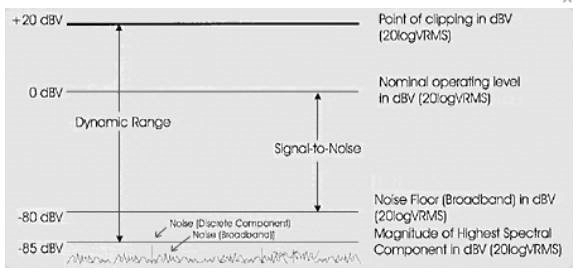Adequate signal-to-noise ratio is one of the characteristics of a professionally designed sound reinforcement system.
The terms “dynamic range” and “signal-to-noise ratio” are often used interchangeably, but a closer look reveals that they are not exactly the same thing.
The dynamic range of a sound system is the difference in level between the highest signal peak that can be reproduced by the system (or device in the system) and the amplitude of the highest spectral component of the noise floor.
Every electronic device has a dynamic range that is determined primarily by the limitations of the power supply and the residual noise level of the unit. A strong narrow band component in a device’s noise floor will limit the dynamic range of the system.
Signal-to-noise ratio is the difference in level between the average signal level and the average level of the noise floor. A device that is being driven to some average out put level with common program material should have peaks that exceed this level by 10 to 20 dB.
This is why we operate mixers near their “0” indication on their meter, and the rest of the available voltage swing is reserved for peaks in the program material. The “average” level is of importance, because it is what we listeners (and meters) use to judge the loudness of the program.
If a voltmeter were used to measure the R. M. S. value of the device’s residual noise, the signal-to-noise ratio will be the difference in level between this value (usually expressed in dBV or dBu) and the nominal “zero” output level ex pressed using the same dB reference. This assumes that the device is being driven to its “meter zero” which is where we like to operate most mixers to optimize their gain structure.
The dynamic range of a system (or component) is not dependent on a signal being present. It’s just the difference between the maximum possible undistorted out put level and the highest component in the noise floor (usually “A” weighted). Signal-to-noise ratio requires a signal, so it must be measured under actual use of the system or component.
A system with wide dynamic range may have poor signal-to-noise due to the way that it is operated. Dynamic range can be used to describe the performance that is possible to achieve with a system or device, whereas signal-to-noise ratio might be used to describe what is actually achieved in practice.
In Practice
A sound level meter could be used to measure the “A” weighted L (sound pressure level) of a live performance at a typical listening position by simply holding the meter in the air, selecting the appropriate scale, and reading the indicator.
The “A” scale is normally used since it is most sensitive to the part of the spectrum where humans are most sensitive (1-4 kHz). Since most sound level meters are of the averaging type, this would yield the average sound level of the performance.
Of course, there will be peaks in the program material that exceed this average value that the meter cannot respond fast enough to read. This “meter lag” is usually on the order of 10 dB but could be higher (or lower) depending on the program material.
Now, if all sound sources on stage were silenced (and mics left open), what would remain would be the noise floor of the system, which could be measured on the same meter in the same fashion. In a properly designed sound system, this noise floor would be established by the ambient pickup of the open microphones (not the residual noise in the electronic components).
In an auditorium with a 40 dBA noise floor, the signal-to-noise ratio at a typical lectern microphone will only be about 37 dB with an average talker (71 dBA @ 2 feet) speaking one foot from the mic. Ten open microphones could increase the noise floor by another 10 dB if their sensitivity and level setting were the same as the lectern mic, since the 10 log (number open mics) = 10 dB.
Unfortunately, the signal-to-noise ratio of the system cannot exceed the worst case condition at the open microphone since the sound system has no choice but to amplify the room noise along with the desired signal. The effects of distant miking and failure to attenuate unneeded mics on the system’s noise floor becomes immediately apparent.

We use 25 dB as the minimum criteria for signal-to-noise ratio on an auditorium sound system with the highest NOM (number-of-open-mics) required for that system.
On the same system, let’s say that the loudest instantaneous sound that the system could produce in a linear fashion was 110 dBA at the same listener position.
Even if the system were operated at a 90 dBA average level, peaks of this magnitude are certainly possible. The highest program peak would be determined by the loudspeaker being used and the available amplifier power connected to it. We now have one ingredient required to find the dynamic range of the system.
If the loudest component of the noise floor were a narrow band “whine” produced by the air conditioner that measured at 35 dBA on a real time analyzer, then the dynamic range of the system would be nothing to get excited about. (110 dBA- 35 dBA = 75 dB). The dynamic range could be increased by fixing the air conditioner to remove the whine.
As you can see from these examples, it is normally the environment that determines both the dynamic range and signal-to-noise ratio of a sound system, as far as the audience is concerned. Because most electronic components in the system have a dynamic range on the order of 100 dB or more, the sound system itself should never be the weak link when it comes to the end result at a listener. A professional system should have a dynamic range of at least 96 dB in the electronics with all devices operating.
Only in a studio or home theater should the equipment noise floor become a factor in determining either the dynamic range or signal-to-noise ratio at a listener position. One could therefore design a sound system with very wide dynamic range, but the overall signal-to-noise ratio could be quite poor due to the room, etc.
One could also design a system with over 100 dB of dynamic range in each component, only to find that the signal-to-noise ratio is drastically reduced during actual use by poor gain structure in the system calibration. The most common cause of this is amplifiers set “wide open”and mixers operated at -20 dBV to compensate.
In designing systems, we choose individual components that have wide dynamic range, and then calibrate and operate the system for the maximum signal-to-noise ratio that we can achieve.
Pat & Brenda Brown lead SynAudCon, conducting audio seminars and workshops online and around the world. For more information go to www.prosoundtraining.com.
SynAudCon is now offering “Audio Applications – System Optimization & EQ” as web-based training. Click the link to see the related article.
More Church Sound articles by Pat Brown on PSW:
How To Illuminate The Audience With Beautiful, Consistent Audio Coverage
Ten Reasons Why Church Sound Systems Cost More
What Makes A Quality Loudspeaker?
















